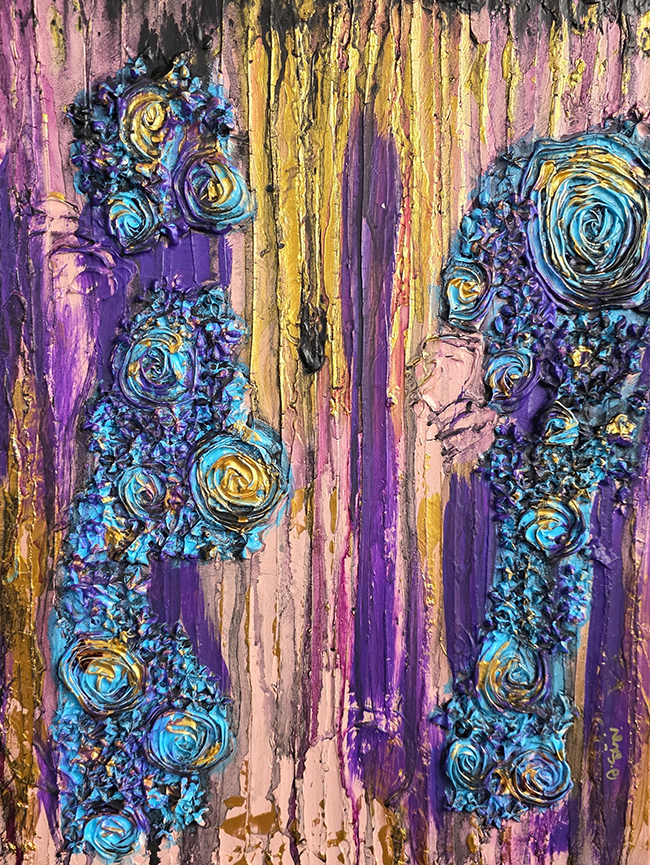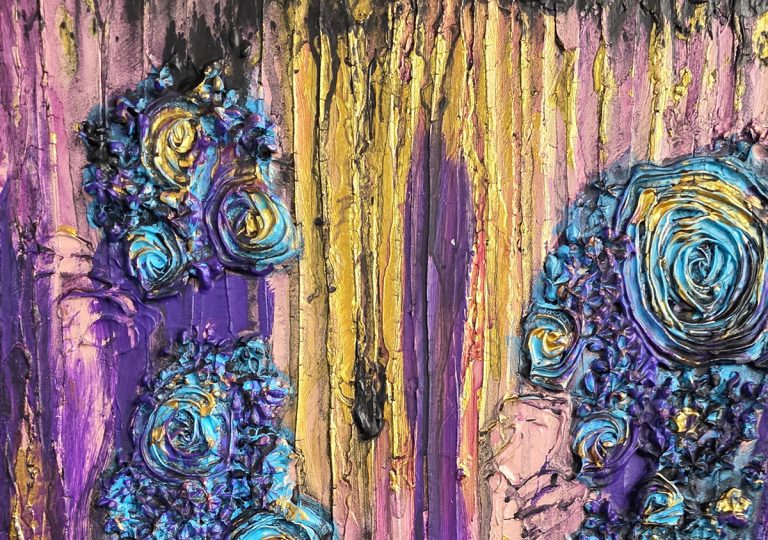Jeanette Seijo paints like someone who remembers how it felt to be wide-eyed at the world. Her work is playful without being naïve—bold color, textured strokes, and scenes that feel halfway between dream and memory. Seijo speaks often about painting as a way to reconnect with her inner child. For her, it’s not just an art practice—it’s a break from the heaviness of modern life. She builds a space where magic is allowed. Where the paint itself seems to laugh a little, and every canvas offers an open invitation: Come in, relax, let the serious stuff wait.

Many of her paintings are filled with characters—sometimes people, sometimes something else entirely—who seem to be caught mid-story. There’s whimsy, there’s emotion, and always a hint of mystery. She’s not trying to explain the world. She’s trying to loosen it up, one brushstroke at a time.
“Freedom Flowers” is one of those works that holds your eye and doesn’t let go. It’s an oil painting full of movement, color, and texture. The piece is painted in heavy impasto, where thick layers of paint rise from the surface like sculpted icing. The paint has body, and that’s important here—the way it lifts off the aluminum gives it energy. Like the painting is stretching itself toward the light.
The first thing that hits you is the color. Bright, iridescent blues swirl with flashes of gold, nestled into purples, pinks, and blackened edges. The strokes are bold and confident. The flowers—if we can call them that—don’t sit politely in a vase. They march. They rise. They speak. Seijo isn’t painting botanical specimens. She’s painting a feeling. Something closer to release.
The background is made up of vertical bands that drip and streak in soft pink, bright violet, burnt gold. They fall like curtains or rain, with the occasional rough burst of black paint grounding everything. In front of this—almost pressed into it—are two floral forms. At a glance, they look like abstract figures made of swirling blossoms. Blue and gold petals clustered like armor. Some blooms spiral tightly, others explode into thickets. There’s something human about their shape, though Seijo leaves it ambiguous. You might see two people passing each other. Or two versions of the same person. Or maybe it’s just the idea of presence and absence, built out of petals.
There’s no delicate framing here. These aren’t flowers trapped in a field or locked into still life. These are flowers moving. These are flowers claiming their own path. Maybe that’s the freedom Seijo is naming. The freedom to bloom your own way—even if it gets messy, even if it doesn’t look how it’s “supposed” to.
What’s interesting is how the color works emotionally. The blue is electric. It doesn’t soothe; it wakes you up. The gold doesn’t sit in the background—it pops and glints, like coins scattered on pavement. The violets are dreamy, but not sleepy. All of it is wrapped in thick, confident texture. You can almost feel the brush dragging through the paint. There’s urgency and joy in it. Not overthought. Just felt.
In “Freedom Flowers,” Seijo seems less interested in traditional beauty and more focused on presence. What it means to take up space. What it means to grow anyway—despite the pressure, despite the chaos. She’s not painting neat gardens. She’s painting wild bloom.
And that’s what she’s good at. Across her body of work, Jeanette Seijo keeps returning to this idea of joy as a rebellious act. Of art as a safe zone for wonder. “Freedom Flowers” fits into that vision. It’s not a quiet painting. It’s not trying to be. It’s vibrant, emotional, alive.
If you sit with it long enough, you might feel the tug to move. To shake off the weight. To grow in your own weird direction. That’s the world Seijo offers—one where the paint sings, the color dances, and flowers don’t ask for permission to bloom.

